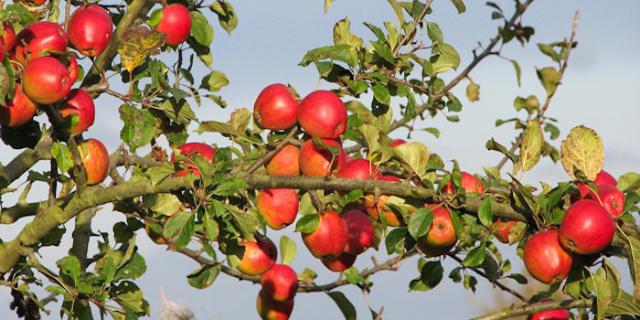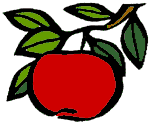All About Apples

In the Diary section a while back, I mentioned that I had acquired 40 pounds of organic apples on sale through my co-op. Using up that windfall, and planning for the apples that are now arriving in my yard and at stands and stores, had me puzzled at first. But there are as many ways to put them by as there are varieties, and endless recipes as well.
Saving fresh apples is a matter of finding (or making) the right spot in your home and getting (or growing) the right kind of apple. You can get as elaborate as a home root cellar if you're going to be storing lots of produce over the winter. You can invest in a second refrigerator. If you live in a climate with cold but relatively mild winters, a Styrofoam cooler in an unheated portion of your basement or garage might even do.
The main thing is, you need to keep the apples at 32-40°F and 80% humidity. And you need to pick the right variety. Good keepers include Granny Smith, Stayman-Winesap, Rome Beauty, Braeburn, Gala, Jonathan, Melrose, Mutsu, Newtown Pippin and Red Delicious.

The most common way to can apples is as sauce; canning apple chunks or pie filling is also an option, and don't forget apple butter (if you're adventurous, try apple jelly). Check the recipes below for more ideas.
With apples, hot water canning is acceptable (as opposed to pressure canning). You must hot pack the jars; wash and sterilize them, keep them hot, and prepare the lids according to manufacturers' instructions. When your apples are ready for canning, fill the jars and leave about 1/4 inch of headspace (or follow your recipes' recommendation). Water bath process pints for 15 minutes, quarts for 20 (or follow your recipes' recommendation).
The easiest method for drying apples is to use a food dehydrator. It is possible to dry apples in your oven or in the sun, but your results won't be as uniform. And I really don't recommend the oven method if you have small children in the house; it requires leaving the oven propped open (preferably with a fan running nearby) at 140° for hours and hours--a real recipe for an accident. If you dry apples in the sun, be sure to put some form of screen over the pieces to keep out bugs.
To prepare apples for drying, core, peel (depending on the variety--if it's thin-skinned, leave the peel on) and slice them thinly. To kill any critters that might be lurking, blanch the slices in hot water or steam for 3-5 minutes. Treating them with citric acid powder is also a good idea to help retard darkening and to retain nutrients. Sulfuring is often recommended but isn't really necessary, and some people are allergic to the sulfuring agents used. Up to you. If you don't sulfur, your end product will be a little darker than the usual dried apples you see in the store.
Apples freeze very well. Core, peel and slice them, and pack them in freezer bags or containers either dry or sprinkled with lemon juice to prevent browning. You can add sweetener if you'd like, but it's not necessary for storage.
One great trick I've heard of is to prepare the apples for pie filling--add all the spices, thickenings, however you like to make it; then take a pie pan, line it with foil, fill it with the apple pie filling, wrap it up and freeze it. Once it's hard, take it out of the pie pan, wrap it for long-term freezer storage, and return it to the freezer. To use, just pop the pie-shaped filling right into your crust and you're ready to go! You'll have to bake it a little longer (I'd put foil over the top crust to avoid over-browning).
Applesauce freezes very well too. I put it in freezer baggies and freeze it flat; once it's hard, you can stack a whole lot of applesauce in a surprisingly small space.
This is really a variation on freezing, since you'll probably want to freeze your juice once you've made it. It can be canned as well, but it seems easier to me to just throw 'er in the freezer. Unpasteurized apple juice lasts about 4 to 5 days in the fridge before it starts to ferment (and making hard cider is beyond the scope of this article). But it'll last 4-6 months in the freezer.
Use a home juicer like the one pictured, or if you really get into it and especially if you have a couple of your own trees, invest in a cider press. Try to use more than one variety and experiment with blending flavors. Try 50% sweet (Golden Delicious or Rome Beauty), 30% tart (Granny Smith, Elstar, Winesap, Jonathan) and 20% fragrant (McIntosh, Golden Delicious, Spartan), but mostly don't use just one kind of apple; you'll end up with bland juice. Pack it in sterilized jugs or jars, or flat in freezer bags like applesauce, and leave at least 1/2" headspace; liquid, as you know, expands when frozen.
There is always a risk of bacterial infection (specifically E. Coli) when you make fresh apple juice, especially if you use "drops" (apples from off the ground). If you are immuno-compromised or if you have small children, consider pasteurizing the juice before drinking/storage by heating it to 160 degrees F and keeping it there for 5 minutes. See this page for more information.

Apples have been domesticated for almost as long as there have been farmers; humanity's earliest writings refer to apple cultivation. Having had so long to tinker with them, we've come up with more than 7,000 different varieties grown around the world, of which 2,500 are grown in the US. 100 varieties are grown here commercially.
Here's a quick but hardly exhaustive rundown of some of the varieties you're likely to encounter, and what their best uses are.
Fresh Eating: Braeburn, Criterion, Elstar, Fuji, Gala, Granny Smith, Golden Delicious, Jonathan, Jonagold, Lady, Liberty, Mutsu, Melrose, McIntosh, Newtown Pippin, Red Delicious, Spartan, Winesap
Baking: Braeburn, Golden Delicious, Granny Smith, Gravenstein, Jonagold, Lady, Liberty, Melrose, Newtown Pippin, Rome Beauty, Winesap
Pies: Braeburn, Golden Delicious, Granny Smith, Gravenstein, Jonagold, Jonathan, Liberty, McIntosh, Melrose, Newtown Pippin, Rome Beauty, Spartan, Winesap
Sauce: Braeburn, Golden Delicious, Granny Smith, Gravenstein, Jonagold, Jonathan, Lady, Liberty, McIntosh, Melrose, Mutsu, Newtown Pippin, Rome Beauty, Spartan, Winesap
Braeburn--Becoming widely available in stores around the US and Canada, this New Zealand apple is a relative newcomer, introduced in 1952. It's a medium to large, crisp, well-flavored yellow-and-red apple, a good keeper and one of the best all-round apples available. Good for eating, baking, pies and sauce. One of my favorites.
Cox's Orange Pippin--This old English variety is a favorite of many "heirloom" gardeners and may be available to home growers and to people lucky enough to have access to specialty orchardists. Considered a dessert apple best for eating out of hand and for pies.
Criterion--A Washington apple introduced in 1970, Criterion is firm, sweet and juicy. Good for cooking and eating.
Elstar--A very new Belgian apple that has one of the best flavors I've ever tasted. Tart but sweet, very crisp, excellent all-round apple for just about any purpose. Watch for it.
Fuji--This descendent of Red Delicious is from Japan, as its name suggests, and was introduced in 1962. A high-quality apple best for eating out of hand, with a crisp, juicy texture and sweet flavor. Good keeper.
Gala--Another New Zealand apple like Braeburn, this medium sized apple has a bright yellow, heavily striped skin. Introduced in the '60s, it's a descendent of Cox's Orange Pippin and Golden Delicious. Best for fresh eating, doesn't keep really well.
Golden Delicious--With its cousin Red Delicious, one of the two apples most familiar to Americans. Goldens were introduced around 100 years ago and are a good, mild-flavored "utility infield" apple, suitable for pies, sauce, baking and eating out of hand. Not a great storage apple, bruising very easily.

Granny Smith--Originating in Australia in 1868 in a real-life "Granny" Smith's orchard, this apple has rapidly become one of the most popular in the world. Very tart, crisp bright green apple that is one of the best varieties for cooking. Fans of tart apples will enjoy eating them out of hand as well. Grannies also are superlative for "spicing up" juice from sweeter apples, but don't to my mind stand up well on their own for juice--best in a blend. Holds well.
Gravenstein--An extremely old variety, dating back to early 17th century Italy. Crisp, spicy, distinctive flavor, unbeaten for cider and juice and a top-notch cooking apple for baking, pies and sauce. Many like to eat them out of hand; I am not among them. I don't care for the texture.
Jonagold--A cross between Golden Delicious and Jonathan introduced in 1968. Very good all-round apple, tasty out of hand; it's crisp, juicy and has a rich flavor. Cooks up beautifully, makes good pies and sauce. Keeps well for about three months.
Jonathan--Introduced in the early 19th century, this is a variant of Esopus Spitzenberg, Jefferson's favorite apple. Moderately tart, juicy, good for fresh eating, pies and sauce.
Lady--An ancient apple cultivated in France since at least the late 16th century, Lady apples are mostly known for their decorative uses; these are the "cute little apples" you're likely to see in holiday wreaths, swags and centerpieces. They're not just cute, they're also good to bake with and do well in juice blends.
Liberty--A terrific apple for the home orchardist, extremely disease-resistant and high-bearing. A sweet and all-round useful apple whose flavor gets better in storage. Picked in October, keeps till February. Introduced in 1978.
McIntosh--A Canadian introduction from the late 19th century, McIntosh is a classic apple with a pleasant tartness. While it's great in pies and sauces, it falls apart in baked goods. Good out of hand if you like tender apples. Good in juice. Fair storage qualities, just making it through the holidays.
Melrose--The official apple of Ohio, where it was introduced during World War II. Cross between Red Delicious and Jonathan. Slightly acid flavor that gets better after Christmas. Good cooking apple, good for eating after it's "set" awhile.
Mutsu--This Japanese apple is a cross between Golden Delicious and Japanese Indo and was bred in 1928. VERY large apple with crunchy flesh, lots of juice and a pleasant tartness. Best for eating fresh, juice and sauce. Unlike its parent, Golden Delicious, Mutsu keeps without shriveling til March.
Newtown Pippin--An old 18th century apple from New York, this is a classic for cider and juice. Green-skinned, crisp and tart, it bakes up beautifully and is an excellent keeper, getting sweeter as it sits.
Red Delicious--The most widely grown apple in the US, and too often bland and unflavorful it is. It is so widespread because it keeps all the way until May if stored well--in other words, it's profitable if not delicious. Grown at home its flavor improves. Good only for eating out of hand; not a terribly good cooking apple.
Rome Beauty--An excellent apple for drying and cooking of all kinds, but not favored for eating out of hand by most because of its mealy raw flesh. Good juicer. Introduced in Ohio in the mid-19th century.
Spartan--A cross between McIntosh and Newtown Pippin, Spartan was introduced in British Columbia in 1936. This apple smells wonderful, and is great fresh and in sauce. Very striking-looking with dark red skin and pure white flesh. Fair keeper.
Winesap--An early 19th century apple from New York, this apple has a very unusual spicy flavor and aroma which sometimes is reminiscent of red wine's tang. Great multipurpose apple that really brings out the best in a juice blend as well as sauces and pies. Excellent keeper, maintaining quality through May.
Apples--at least two different varieties is best
Water
Cinnamon if desired
Cloves if desired
Sweetener if desired
Core, peel and quarter the apples; put them in a pot with plenty of head room. Add enough water to come up about halfway to the top of the apples. Bring to a boil, then simmer until the apples are soft. I like to mash half of them and leave the other half chunky, but that only works if you're using an apple that holds its shape; sometimes you get a smooth sauce no matter what. Taste what you've got. Chances are it's plenty sweet, but if you like your applesauce really sweet add sugar or honey to taste. Sprinkle a little ground cinnamon and cloves in if you'd like, but keep a light hand.
You can serve it immediately warm from the pot; over gingerbread, it's a real treat, or just by itself. Applesauce also cans and freezes very well. To can, sterilize your jars and prepare your lids according to the manufacturers' instructions. Keep the jars hot. Ladle the hot applesauce into the jars, and leave at least 1/4" headspace. Wipe the rims clean, seal the lids and process in a hot water or steam canner for 10 minutes for pint jars, 15 minutes for quarts. To freeze, just ladle the applesauce into freezer containers or bags and pop into the freezer. Use it up before 6 months.
Dry Ingredients:
2 cups plain flour
2 cups sugar
1/2 teaspoon salt
2 teaspoons cinnamon
1 teaspoon baking soda
Liquid ingredients:
3 eggs
1 cup oil
1 teaspoon vanilla extract
4 cups thinly sliced apples
Sift all dry ingredients together. Add liquid to dry ingredients, mix well, by hand. Add apples last. (This mixture will be very thick.) Pour into greased bundt pan. Bake at 350 degrees for 40-45 minutes. Let cake cool slightly and then glaze.
Glaze Ingredients:
1 stick butter
1 cup sugar
3/4 cup Pet Milk
1 teaspoon vanilla
Mix ingredients together, bring to a boil; boil 4-5 minutes, until desired consistency. Punch holes in cake with fork and pour glaze over warm cake.
--from Alyce Powell, Sebree, Kentucky
1/2 c brown sugar
1/2 c white sugar
1/2 tsp nutmeg
1 tsp of cinnamon
juice from half a lemon
1 oz brandy
1 oz Triple Sec
Combine and toss with the apples for your pie.
One large apple per person
Butter
Brown Sugar
Cinnamon
Raisins, if desired
Walnuts or hazelnuts, chopped, if desired
Core the apples; leave them unpeeled. Place the apples in a lightly buttered or no-stick baking dish. In the center of each one, put a generous pat of butter, a generous spoonful of brown sugar, some nuts and raisins if you wish, a bit more butter on top of the raisins and nuts, and a sprinkle of cinnamon. Bake at 350° until the apples are soft. Serve with fresh whipped cream, ice cream or nothing at all but their ownselves.
From the University of Illinois Extension Service's Apples & More pages:
1 8-inch pie crust
1 1/2 cups pumpkin puree
3 medium cooking apples, peeled, cored and diced
1/2 cup apple cider
2 tablespoons honey
1/2 cup sugar
2 eggs plus 2 egg whites, slightly beaten
1/2 cup currants
1 teaspoon cinnamon
1/8 teaspoon nutmeg
1/2 teaspoon dried thyme
1/2 teaspoon dried marjoram
1/2 teaspoon salt
Prepare crust and press into an 8-inch fluted tart pan. Use a rolling pin to roll over the edges, making crust even with top of tart pan. Place in the freezer while assembling tart filling. Preheat oven to 425 degrees. In a mixing bowl, combine all the tart ingredients and mix well. Scrape the filling into the prepared tart shell. Smooth evenly around the pan. Bake 15 minutes at 425 degrees, then reduce the heat to 350 degrees and continue to bake for 40 minutes. Allow to cool before serving. Top with whipped cream, if desired.
From the Washington Apple Growers' bestapple.com site:
1/2 cup plus 1 tablespoon all-purpose flour
1/2 teaspoon salt
1/2 teaspoon black pepper
4 lean boneless pork steaks (3 ounces each)
3 tablespoons butter or margarine
2 tablespoons vegetable oil
2 Jonagold or Golden Delicious apples, peeled, cored, and sliced
2 tablespoons minced onion
1 cup apple juice
1/2 cup dry white wine
1/2 cup plain low fat yogurt
2 tablespoons Dijon-style prepared mustard
1/4 teaspoon dried thyme leaves
- In pie plate or shallow dish, combine 1/2 cup flour, 1/4 teaspoon salt, and 1/4 teaspoon pepper. Dredge pork
steaks in flour mixture to coat all sides lightly. In large skillet, heat 2 tablespoons butter and the oil over medium
heat; add pork and cook until brown on both sides and juices run clear. Remove pork steaks to heated platter and
reserve. - Add remaining tablespoon butter to skillet; saute apples and onions until both are tender. Remove apples to platter with pork. Add apple juice and wine to skillet; simmer 5 minutes.
- Combine yogurt, mustard, thyme, and remaining tablespoon flour and 1/4 teaspoon salt; stir into apple juice mixture. Simmer 5 minutes, stirring until smooth. Spoon sauce over pork steaks and apples and serve. Serves 4.
Apple Stack Cake: A six-layer cake made with dried apples.
All the recipes with apples or apple juice in them at SOAR: Everything from Apple-Cheese Ice Cream (really) to Salmon with Pears, Apples and Limes.
Lynn Siprelle loves loves LOVES apples.
